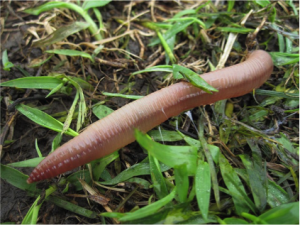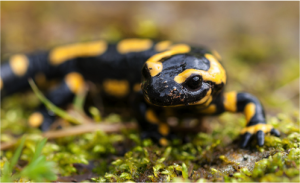Take a deep breath in, now breathe out. When you breathe, your lungs take in oxygen. Then the oxygen is taken in by your blood. Your blood delivers oxygen to all the parts of your body. Every part of your body needs oxygen to work! Every creature needs oxygen, but not every creature breathes it in through their mouth or nose. Here are some creatures that breathe through their skin.
Earthworms
 Earthworms are creepy crawly creatures that live in the dirt underground. Earthworms don’t have lungs so they take in oxygen through their skin.
Earthworms are creepy crawly creatures that live in the dirt underground. Earthworms don’t have lungs so they take in oxygen through their skin.
Their are 6,000 different kinds of earthworms found all over the world. You have probably seen some in your backyard. Some of the most common backyard earthworms are night crawlers, anglers and rainworms.
Earthworms eat soil and decomposing things like leaves. Did you know that earthworms are great for gardens and compost, but they are not so good for forests? Earthworms are not originally from forests in the north part of the United States. They were brought there from Europe and other places to help with farming and gardening. Too many earthworms can eat up the decaying leaves that trees like sugar maples rely on for healthy growth.
Frogs
Frogs breathe in three different ways. One way is through their skin. The membranes, which means a special layer of tissue, on their skin allow oxygen to be absorbed from water or air right into their blood stream. They can can also take in air through their nostrils into a small lung. Frog’s lungs don’t work as well as people’s lungs so they don’t use this method often. Frog’s also have a membrane in their mouth that can take in oxygen.
When frogs hatch from their eggs they are called tadpoles. They have a tail and no arms or legs. They spend all of their time swimming in the water. As they grow, arms and legs start to grow too and their tail disappears. When they are grown they can hop out on land. Frogs like to spend a lot of time in the water, but they can also live on land. Their skin usually feels slippery and moist, which keeps them from drying out when they are on land.
Frogs use long sticky tongues to snatch up the insects they like to eat. They are usually green or brown colored to help them hide in the places they like to live. Frogs that are brightly colored are usually poisonous. Their bright colors warn predators not to eat them.
Salamanders
 Salamanders look like little lizards, but they are not reptiles. Salamanders are amphibians, part of the same family as frogs! They are long and skinny with a short nose and short arms and tails.
Salamanders look like little lizards, but they are not reptiles. Salamanders are amphibians, part of the same family as frogs! They are long and skinny with a short nose and short arms and tails.
These creatures need to stay moist and live near water like ponds and creeks. Some salamanders have to live in water all of their lives, these creatures keep their gills and continue to breathe through them as they grow. Other salamanders develop lungs and breathe through their mouths and nostrils. Most salamanders don’t have lungs or gills and take in air through their skin and membranes in their mouth, like frogs.
These creatures are nocturnal, which means they are active at night. They usually have bright colors and patterns on their skin. The biggest type of salamander in the world can be found in Japan. It grows up to 6 feet tall, that is as tall as person! Most salamanders are between only 2 and 6 inches long.
Some salamanders have the ability to grow back injured legs, tails or arms. This protects them from attacks by predators.
A Special Way to Breathe
These amazing creatures all have special adaptations for living in their individual habitats. They can hide from predators, snatch prey with sticky tongues, and even grow back parts of their body! Earthworms, frogs, and salamanders all have a very special way of breathing that is perfect for the places they live. Oxygen is important for every creature, while we might find it easy to breath in and out, these creatures sit back and let their skin do the work. Thanks for exploring these creatures with me, Jungle Jim! For more fun animal facts, watch my fun music videos!
Sources
“10 Interesting Facts About Earthworms” EcoWatch
“Frog and Toad Facts” LiveScience
“Salamander and Newt” San Diego Animals
